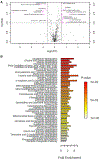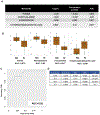Diagnostic Utility of Serum and Urinary Metabolite Analysis in Patients with Interstitial Cystitis/Painful Bladder Syndrome
- PMID: 34010675
- PMCID: PMC10461181
- DOI: 10.1016/j.urology.2021.05.005
Diagnostic Utility of Serum and Urinary Metabolite Analysis in Patients with Interstitial Cystitis/Painful Bladder Syndrome
Abstract
Objective: To identify the potential biomarkers of interstitial cystitis/painful bladder syndrome (IC), a chronic syndrome of bladder-centric pain with unknown etiology that has an adverse impact on quality of life, we analyzed the urine and serum metabolomes of a cohort of IC patients and non-disease controls (NC).
Methods: Home collection of serum and urine samples was obtained from 19 IC and 20 NC females in the Veterans Affairs (VA) Health Care System. IC was diagnosed independently by thorough review of medical records using established criteria. Biostatistics and bioinformatics analyses, including univariate analysis, unsupervised clustering, random forest analysis, and metabolite set enrichment analysis (MSEA), were then utilized to identify potential IC biomarkers.
Results: Metabolomics profiling revealed distinct expression patterns between NC and IC. Random forest analysis of urine samples suggested discriminators specific to IC; these include phenylalanine, purine, 5-oxoproline, and 5-hydroxyindoleacetic acid. When these urinary metabolomics-based analytes were combined into a single model, the AUC was 0.92, suggesting strong potential clinical value as a diagnostic signature. Serum-based metabolomics did not provide potential IC discriminators.
Conclusion: Analysis of serum and urine revealed that women with IC have distinct metabolomes, highlighting key metabolic pathways that may provide insight into the pathophysiology of IC. The findings from this pilot study suggest that integrated analyses of urinary metabolites, purine, phenylalanine, 5-oxoproline, and 5-HIAA, can lead to promising IC biomarkers for pathophysiology of IC. Validation of these results using a larger dataset is currently underway.
Copyright © 2021. Published by Elsevier Inc.
Conflict of interest statement
Conflicts of Interest.
Some of authors declare conflict of interest. B.G., N.N., V.B., V.T., and M.K. are employees of BERG Health. The other authors have nothing to disclose.
Figures



Comment in
-
Voiding Function and Dysfunction, Bladder Physiology and Pharmacology, and Female Urology.J Urol. 2022 Jun;207(6):1352-1356. doi: 10.1097/JU.0000000000002662. Epub 2022 Mar 24. J Urol. 2022. PMID: 35321553 No abstract available.
References
-
- Hanno PM, Erickson D, Moldwin R et al. : Diagnosis and treatment of interstitial cystitis/bladder pain syndrome: AUA guideline amendment. J Urol, 193: 1545, 2015 - PubMed
-
- Bogart LM, Berry SH, Clemens JQ: Symptoms of interstitial cystitis, painful bladder syndrome and similar diseases in women: a systematic review. J Urol, 177: 450, 2007 - PubMed
-
- Buffington CA: Re: Symptoms of interstitial cystitis, painful bladder syndrome and similar diseases in women: a systematic review: L. M. Bogart, S. H. Berry and J. Q. Clemens. J Urol 2007; 177: 450–456. J Urol, 178: 1121, 2007 - PubMed
MeSH terms
Substances
Grants and funding
LinkOut - more resources
Full Text Sources
Other Literature Sources
Medical

